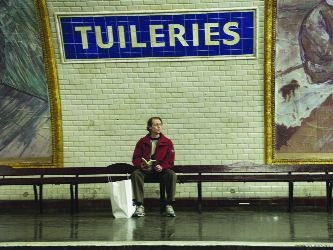Paris forever

The city of lights would seem the perfect setting for a compilation of 18 short films, each five to eight minutes long, about love and passion. But what makes Paris, Je T’Aime intriguing, beyond its role as a travelogue of Parisian neighborhoods, is that it offers a rare chance to observe in one sitting how numerous writers, directors and cinematographers—some famous, some not—employ different cinematic tools. Think flashback and flash-forward, fantasy and dreams, jerky hand-held camera work and all sorts of camera and editing gimmicks. This approach also allows us to consider which of the films are too long for their own good, too slight in terms of message or too overt in terms of theme.
The original concept was to present one film for each of Paris’s 20 arrondissements or districts. But two film efforts were rejected by the producers, so the project became one of sampling different neighborhoods—the rich and poor, famous and infamous, safe and dangerous and, perhaps most important to the directors, light and dark. The result is an eclectic mix of drama, comedy and melancholy, with a dollop of the bittersweet.
Many of the films have to do with relationships, ending or beginning. In “Quartier Latin,” Ben Gazzara and Gena Rowlands say a final goodbye after failing to keep their long marriage afloat. In “Père-Lachaise,” Emily Mortimer and Rufus Sewell avoid a rocky beginning to their engagement, thanks to the ghost of Oscar Wilde (Alexander Payne). In “Bastille,” Sergio Castellitto discovers a long-dormant love for his wife, Miranda Richardson, when he finds out that she has cancer. In “Montmartre,” Bruno Podalydès falls in love with a young woman (Florence Muller) who faints next to his car. In “Quartier des Enfants Rouges,” Maggie Gyllenhaal portrays an American actress who finds herself drawn to her local drug dealer (Lionel Dray), and in “Faubourg Saint-Denis,” a blind man (Melchior Beslon) considers the inevitable end of his relationship with a young actress, played by Natalie Portman.
Issues involving immigration also crop up. In “Quais de Seine,” a teenage French boy (Cyril Descours) finds himself attracted to a young Muslim woman (Leïla Bekhti), despite the jeers and warnings of his foul-mouthed friends, and in “Place des Fêtes,” an idealistic, if inexperienced, emergency medical technician (Aïssa Maïga) is drawn to a wounded immigrant (Seydou Boro) from Africa.
Romantic love is not the only type of amour that is featured. In “Place des Victoires,” Juliette Binoche plays a mother coping with the recent death of her son, while “Porte de Choisy” turns out to be a musical tribute to the glories of French fashion.
Several of the filmmakers employ the element of surprise to drive their tales, but these prove to be the weakest of the lot, relying on twists to force a response. The most successful segment focuses almost exclusively on one character.
In “Tuileries,” the funniest segment, Steve Buscemi is an American tourist who commits the cardinal sin of “making eye contact” in a Paris metro station. In “Loin du 16ème,” Catalina Sandino Moreno is laconic and heartbreaking as a young mother who must leave her own baby behind to work as a nanny for a wealthy woman.
The final and most successful of all the shorts is “14ème Arrondissement,” written and directed by Alexander Payne (Sideways). Margo Martindale plays Carol, a frumpy postwoman from Denver on the first European trip of her life, complete with sensible shoes and fanny pack. As she walks down the narrow streets and gazes at the scenery, she finds herself wishing that she had someone beside her to enjoy the moment. Just when it seems that the film is going to end on a sad note, Payne delivers a remarkable ending—the perfect ending not only for this story but for the entire collection, which blows a kiss to the city and tells us, “We’ll always have Paris.”




